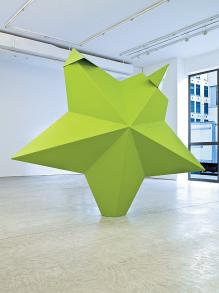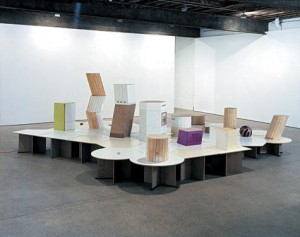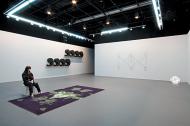For ‘Time Out New York’ Magazine
Mark Handforth’s latest solo show offers work that is both chic and out of fashion. Bold new sculptures in his usual cheeky minimalist style are a big contrast to the ephemeral and intuitive artwork being championed in the major survey shows at the New Museum and Whitney right now. Yet his best pieces combine monumentality with humor and whimsy to exert a sophisticated, mysterious charm.
Hugging the gallery building outside, an impossibly long-necked lamppost bent into a star shape extends its top around its base like a seductively crossed leg. Inside, a similarly exploded sense of scale turns a long piece of rusty pipe, bent into a heart and dotted with colorful burning candles, into a towering declaration of love. Whether the source is freshly mass-produced or just junk metal, Handforth’s amusingly capricious sculptures suggest evidence of a powerful unseen hand, a kind of giant Gabriel Orozco cum Boo Radley.
But when the readability of Handforth’s sculptures is too easy, as with the three pieces in the back gallery, it becomes clear why so many younger artists are rebelling against this sort of aesthetic. A star with two broken tips dominates the room, and also appears on an announcement card for the show in which it is ironically depicted as standing in for Mammon, Lucifer’s demonic follower in Paradise Lost. The piece’s lasting impression, however, like that of two snake-like coils of ropes and a light installation depicting a tumbleweed, is signature Handforth: made to please the eye and titillate with a knowing yet shallow allusions.


